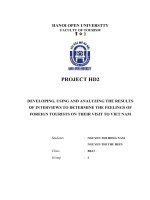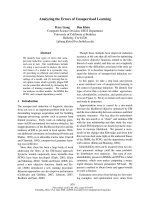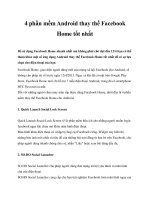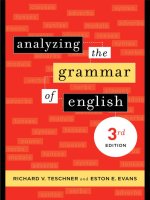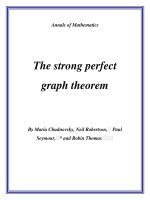analyzing the facebook friendship graph
Bạn đang xem bản rút gọn của tài liệu. Xem và tải ngay bản đầy đủ của tài liệu tại đây (473.24 KB, 6 trang )
Analyzing the Facebook Friendship Graph
Salvatore Catanese
1
, Pasquale De Meo
2
, Emilio Ferrara
3
, Giacomo Fiumara
1
1
Dept. of Physics, Informatics Section. University of Messina.
;
2
Dept. of Computer Sciences, Vrije Universiteit Amsterdam.
3
Dept. of Mathematics. University of Messina.
Abstract. Online Social Networks (OSN) during last years acquired a
huge and increasing popularity as one of the most important emerging
Web phenomena, deeply modifying the behavior of users and contribut-
ing to build a solid substrate of connections and relationships among
people using the Web. In this preliminary work paper, our purpose is
to analyze Facebook, considering a significant sample of data reflecting
relationships among subscribed users. Our goal is to extract, from this
platform, relevant information about the distribution of these relations
and exploit tools and algorithms provided by the Social Network Anal-
ysis (SNA) to discover and, possibly, understand underlying similarities
between the developing of OSN and real-life social networks.
Keywords: social networks, analysis, visualization, graphs, data mining
1 Introduction
The problem of analyzing social networks was already introduced during late
sixties by Milgram [18] and Travers [23] in Psychology and Sociology. Starting
from this point for twenty and more years, several kind of real-life social exper-
iments have been conducted and studied by sociologists, trying to understand
motivations, dynamics and rules of real-life social networks.
During last years the Web phenomenon of OSN started spreading and compu-
tational aspects have also been considered [3, 15, 22]. Several Social Networking
Services were developed, most of them gathered millions of users in an incredible
short amount of time. The OSN we are considering in this work is Facebook
4
,
which collected more than 500 millions of world-wide users as of July 2010.
The unpredicted success and the fast growing rate of these platforms shortly
opened new fascinating academic problems; e.g. it is possible to study OSN
with tools provided by the SNA science [19]? Is the behavior of OSN users
comparable with the one showed by actors of real-life social networks [12]? What
are the topological characteristics of OSN [2]? And what about their structure
and evolution[16]? Today we exploit computational resources to analyze data
4
acquired from OSN, trying to answer to these problems. In this work, we analyze
connections among almost a million of Facebook users, data collected through
some developed ad hoc Information Extraction techniques.
This paper is organized as follows: in Section 2 we consider related works
on social networks, OSN, etc., in particular regarding data mining experiments
and SNA; Section 3 covers aspects of Artificial Intelligence and Information
Extraction related to algorithms and techniques used in order to acquire and
gather data from Facebook; Section 4 presents collected data, focusing on their
statistical analysis, exploiting some tools provided by the SNA science. In Section
5 we try to graphically plot this information, i.e., a large graph where nodes
represent users and edges reflect ties among them. Section 6 concludes, providing
some suggestions for future work.
2 Related Work
Literature on Web (and social Web) data extraction is growing: Ferrara et al. [10]
provided a comprehensive survey on applications and techniques. In [9], Ferrara
and Baumgartner developed some techniques for automatic wrapper adaptation.
A slightly modified version of that algorithm, relying on analyzing structural
similarities inside the DOM tree structure of Facebook friend-list pages, is the
core of the agent used here to gather data.
A common SNA task is to discover, if existing, aggregations and subsets
of nodes playing similar roles or occupying a particular position in a network
[7]. Some strictly connected problems are related to optimizing the visual rep-
resentation of graphs [4]; for large social networks graphs is not trivial to find
a meaningful graphical representation, because of the number of elements to
display, and finding algorithms for the planar embedding of the graph, so as
reducing (or eliminating) intersecting edges and improving aesthetic and func-
tional characteristics of the graph itself, is part of the solution [5].
Several SNA tools have been developed during the last years: GUESS [1] fo-
cuses on improving the interactive exploration of graphs; NodeXL [21], developed
as an add-in to the Microsoft Excel 2007 spreadsheet software, provides tools
for network overview, discovery and exploration. LogAnalysis [8] helps forensic
analysts in visual statistical analysis of mobile phone traffic networks. Jung [17]
and Prefuse [14] provide Java APIs implementing algorithms and methods for
building applications for graphical visualization and SNA for graphs.
3 Data Extraction and Data Cleaning Aspects
The very first step of a SNA experiment is acquiring data: for this purpose we
designed and developed a custom agent, an automaton simulating the behav-
ior of real users, visiting Facebook publicly accessible profiles and automatically
extracting relationships among them. Once acquired, information must be col-
lected in some kind of well-structured format; completed this process, data must
be cleaned, removing duplicates and irrelevant information, then they are ready
to be used for their purpose.
In order to acquire information about friendship relations, we developed an
agent that automatically visits the friend-list page of a real user seed profile,
and then recursively, acquires friendship relations visiting friend-list pages of
friends of the seed, and so on, down to the third sub-level of friendship relations.
Only friendship relations among real users have been acquired, fan pages and
companies having been discarded (Facebook provides this filter). This agent
acquires information only from profiles in friendship relation with the seed and
from publicly accessible profiles, thus respecting the Facebook privacy policies.
We thus obtained an undirected graph composed of 547,302 vertices and
836,468 edges; for privacy reasons only user IDs were collected. The agent was
developed in Java, and it embeds a Firefox browser interfaced through XPCOM
5
and XULRunner
6
.
Facebook profiles are saved as GraphML [6] nodes with one attribute, namely
the Facebook ID. Friendship relations are saved as undirected edges connecting
two nodes. Because of the intrinsic nature of the data mining process, it could
happen to save parallel edges and multiple instances of the same node. We
developed a fast algorithm of data cleaning, running in O(n log n), exploiting
the hash property of the Java HashSet, which, first of all removes all duplicate
nodes and, then, fixes all edges in order to link the unique instance of source
and target nodes and, finally, deletes the parallel ones.
4 Data Analysis
SNA provides some useful techniques to analyze dynamics of relationships: it
is possible to identify models and flows, in the structure of the network, e.g.
trying to understand which role actors play in the environment they are placed
in. Several statistical algorithms are helpful in discovering key nodes, creating
groups of social cohesion [24]. However, it is not trivial to discover models or
anomalies while dealing with huge amount of data; in these cases, visualization
of information, on the one hand, could be useful to simplify the work of analysis,
but on the other hand, could be tricky for several reasons. The computational
cost is very high and increases with the dimension of data; it becomes harder
and harder to understand graphs showing thousands of nodes and edges, also
because of overlapping elements. For these reasons we shall analyze data using
filters and clustering methods.
4.1 Metrics and Measures
The following measures for SNA have been standardized by Perer and Shneider-
man [20]: overall network metrics (number of nodes, number of edges, density,
5
/>6
/>diameter), node rankings (degree, betweenness and closeness centrality), edge
rankings (weight, betweenness centrality), edge rankings in pairs and cohesive
subgroups. A short summary of some metrics, evaluated using NodeXL, follows.
Graph Type: Undirected
Vertices: 547,302
Unique Edges: 836,468
Edges With Duplicates: 0
Total Edges: 836,468
Self-Loops: 0
Connected Components: 2
Single-Vertex Connected Components: 0
Maximum Vertices in a Connected Component: 546,733
Maximum Edges in a Connected Component: 835,951
Maximum Geodesic Distance (Diameter): 10
Average Geodesic Distance: 5.00
Table 1. Overall Network Metrics
Minimum Maximum Average Median
Degree 1 4,958 3.057 1.000
PageRank 0.269 2120,268 1.000 0.491
Clustering Coefficient 0.000 1.000 0.053 0.000
Eigenvector Centrality 0.000 0.003 0.000 0.000
Table 2. Miscellaneous Metrics
5 Visualization
Analyzing large graphs is not a trivial problem: the computational cost of visu-
alization algorithms, e.g. Fruchterman-Reingold [11], Harel-Koren [13], etc., is
critical, and finding useful information is hard. For this reason the SNA relies
on filtering data calculating metrics and displaying only relevant information.
We produced several subgraphs for SNA and visualization purposes (see Fig-
ure 1). In Figure 1B nodes are arranged according to betweenness centrality
(BC). As the definition of BC implies, nodes in the central region of the plot
show higher values of BC, thus occurring in a correspondingly higher number
of shortest paths connecting all the nodes each others. Intuitively, nodes with
higher BC values have higher relevance as they represent a potential efficient
way of establishing friendship relations among peripheral nodes.
6 Conclusions
In this preliminary work we focused on the possibility of extracting relevant
information about relationships from Facebook. We developed an automaton
Fig. 1. [A] Visualization of a 25,000 nodes subgraph; [B] Top 50 nodes ordered by
betweenness centrality; [C] Nodes with high betweenness centrality (greater than 10
millions); [D] Clusterization after 10 iterations of the Fruchterman-Reingold algorithm.
for data mining and cleaning, gathered a sample dataset of almost a million
of connections, and finally analyzed data applying SNA tools and techniques.
Our purpose is to continue acquiring data and we already developed a more
efficient way of data mining, and then to improve algorithms for data analysis
and visualization, e.g. exploiting the auto parallelization and High Performance
Computing techniques to handle in the most efficient way the huge amount of
useful information we can gather from Facebook.
References
1. Adar, E.: Guess: a language and interface for graph exploration. In: CHI ’06:
Proceedings of the SIGCHI conference. pp. 791–800. ACM, NY, USA (2006)
2. Ahn, Y.Y., Han, S., Kwak, H., Eom, Y.H., Moon, S., Jeong, H.: Analysis of topo-
logical characteristics of huge online social networking services. Proceedings of the
16th international conference on World Wide Web pp. 853–844 (2007)
3. Barabasi, A.L., Crandall, A.R.E., Reviewer: Linked: The new science of networks.
American Journal of Physics 71(4), 409–410 (2003)
4. Battista, G.D., Eades, P., Tamassia, R., Tollis, I.: Algorithms for drawing graphs:
an annotated bibliography. Computational Geometry 4(5), 235–282 (Oct 1994)
5. Boyer, J.M., Myrvold, W.J.: On the Cutting Edge: Simplified O(n) Planarity by
Edge Addition. J. of Graph Algorithms and Applications 8(3), 241–273 (2004)
6. Brandes, U., Eiglsperger, M., Herman, I., Himsolt, M., Marshall, M.S.: GraphML
Progress Report Structural Layer Proposal. Lecture Notes in Computer Science
2265, 109–112 (2002)
7. Carrington, P.J., Scott, J., Wasserman, S.: Models and methods in social network
analysis. Cambridge ; New York : Cambridge University Press (2005)
8. Catanese, S., Fiumara, G.: A visual tool for forensic analysis of mobile phone
traffic. In: MiFor ’10: Proceedings of the Second ACM workshop on Multimedia in
forensics (2010)
9. Ferrara, E., Baumgartner, R.: Automatic wrapper adaptation by tree edit distance
matching. Combinations of Intelligent Methods and Applications pp. 41–54 (2011)
10. Ferrara, E., Fiumara, G., Baumgartner, R.: Web Data Extraction, Applications
and Techniques: A Survey. Technical Report (2010)
11. Fruchterman, T.M.J., Reingold, E.M.: Graph drawing by force-directed placement.
Software: Practice and experience 21(11), 1129–1164 (1991)
12. Garton, L., Haythornthwaite, C., Wellman, B.: Studying online social networks.
Journal of Computer-Mediated Communications 3(1) (1997)
13. Harel, D., Koren, Y.: A fast multi-scale method for drawing large graphs. In: AVI
’00: Proceedings of the working conference on Advanced visual interfaces. pp. 282–
285. ACM, New York, NY, USA (2000)
14. Heer, J., Card, S.K., Landay, J.A.: prefuse: a toolkit for interactive information vi-
sualization. Proceedings of the SIGCHI conference on Human factors in computing
systems - CHI ’05 p. 421 (2005)
15. Kleinberg, J.: The small-world phenomenon: an algorithm perspective. In: STOC
’00: Proceedings of the thirty-second annual ACM symposium on Theory of com-
puting. pp. 163–170. ACM, New York, NY, USA (2000)
16. Kumar, R., Novak, J., Tomkins, A.: Structure and Evolution of Online Social
Networks. Proceedings of the 12th ACM SIGKDD international conference on
Knowledge discovery and data mining pp. 611–617 (2006)
17. Madadhain, J., Fisher, D., Smyth, P., White, S., Boey, Y.: Analysis and visualiza-
tion of network data using JUNG. Journal of Statistical Software VV(II) (2005)
18. Milgram, S.: The Small World Problem. Psychology Today 1(1), 61–67 (1967)
19. Mislove, A., Marcon, M., Gummadi, K.P., Druschel, P., Bhattacharjee, B.: Mea-
surement and Analysis of Online Social Networks. Proceedings of the 7th ACM
SIGCOMM conference on Internet measurement pp. 29–42 (2007)
20. Perer, A., Shneiderman, B.: Balancing systematic and flexible exploration of social
networks. IEEE TVCG 12(5), 693–700 (2006)
21. Smith, M.a., Shneiderman, B., Milic-Frayling, N., Mendes Rodrigues, E., Barash,
V., Dunne, C., Capone, T., Perer, A., Gleave, E.: Analyzing (social media) networks
with NodeXL. Proceedings of the fourth international conference on Communities
and technologies - C&T ’09 p. 255 (2009)
22. Staab, S., Domingos, P., Mika, P., Golbeck, J., Ding, L., Finin, T., Joshi, A.,
Nowak, A., Vallacher, R.R.: Social networks applied. IEEE Intelligent Systems
20(1), 80–93 (2005)
23. Travers, J., Milgram, S.: An experimental study of the small world problem. So-
ciometry 32(4), 425–443 (1969)
24. Wasserman, S., Faust, K.: Social network analysis: methods and applications. Cam-
bridge University Press, 1st edn. (1994)
